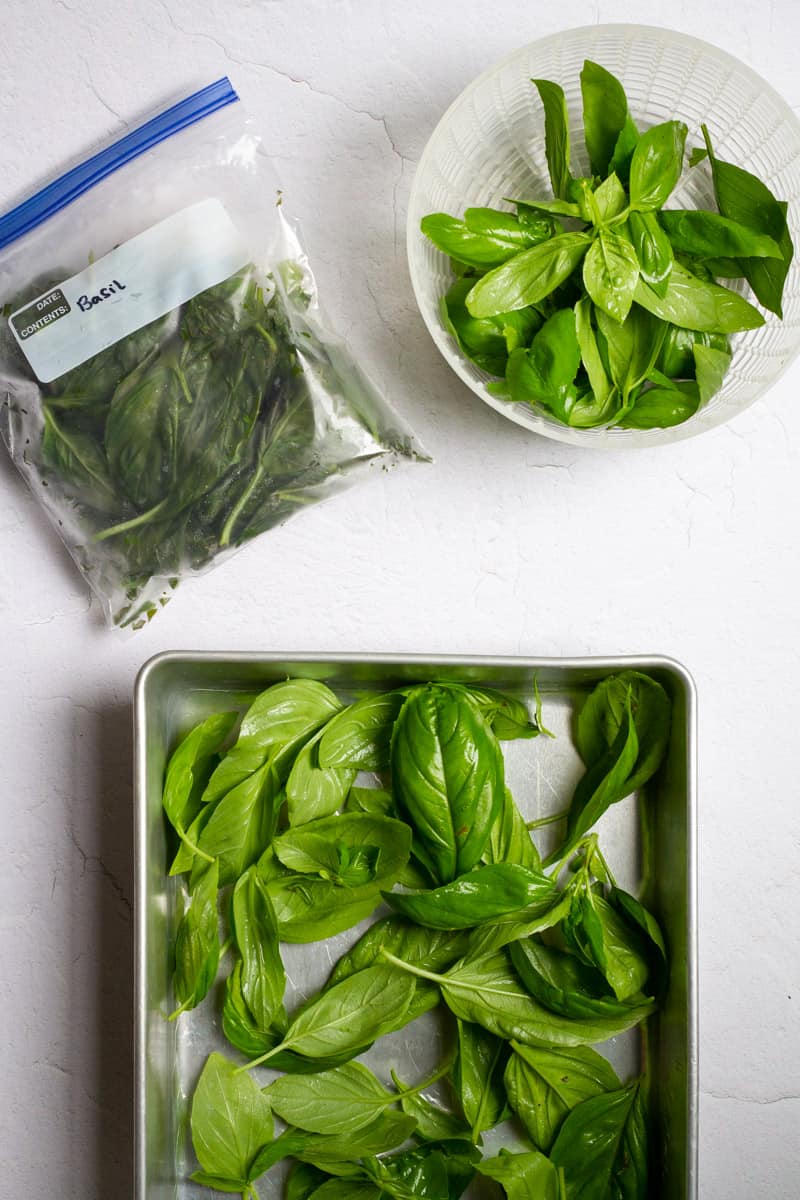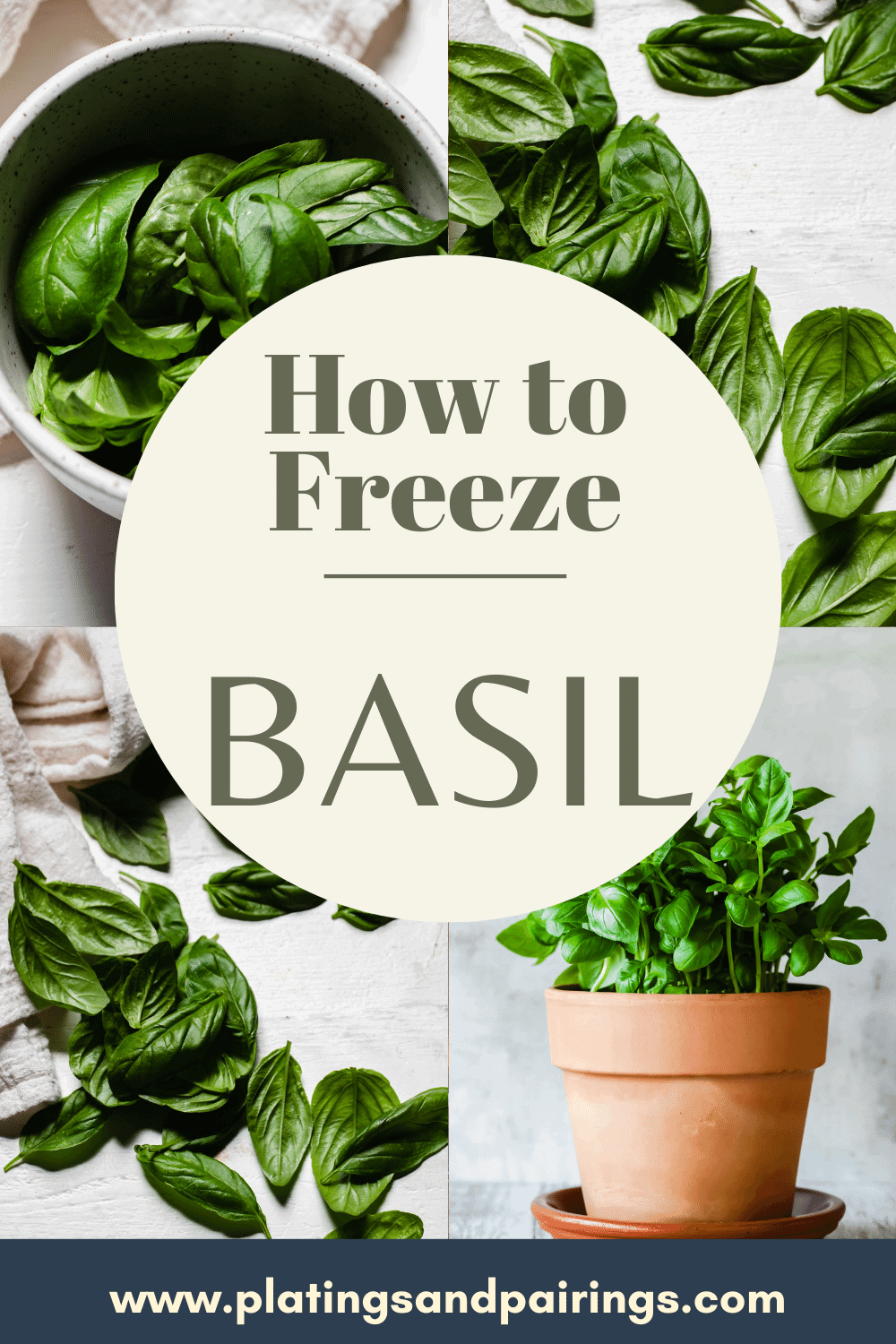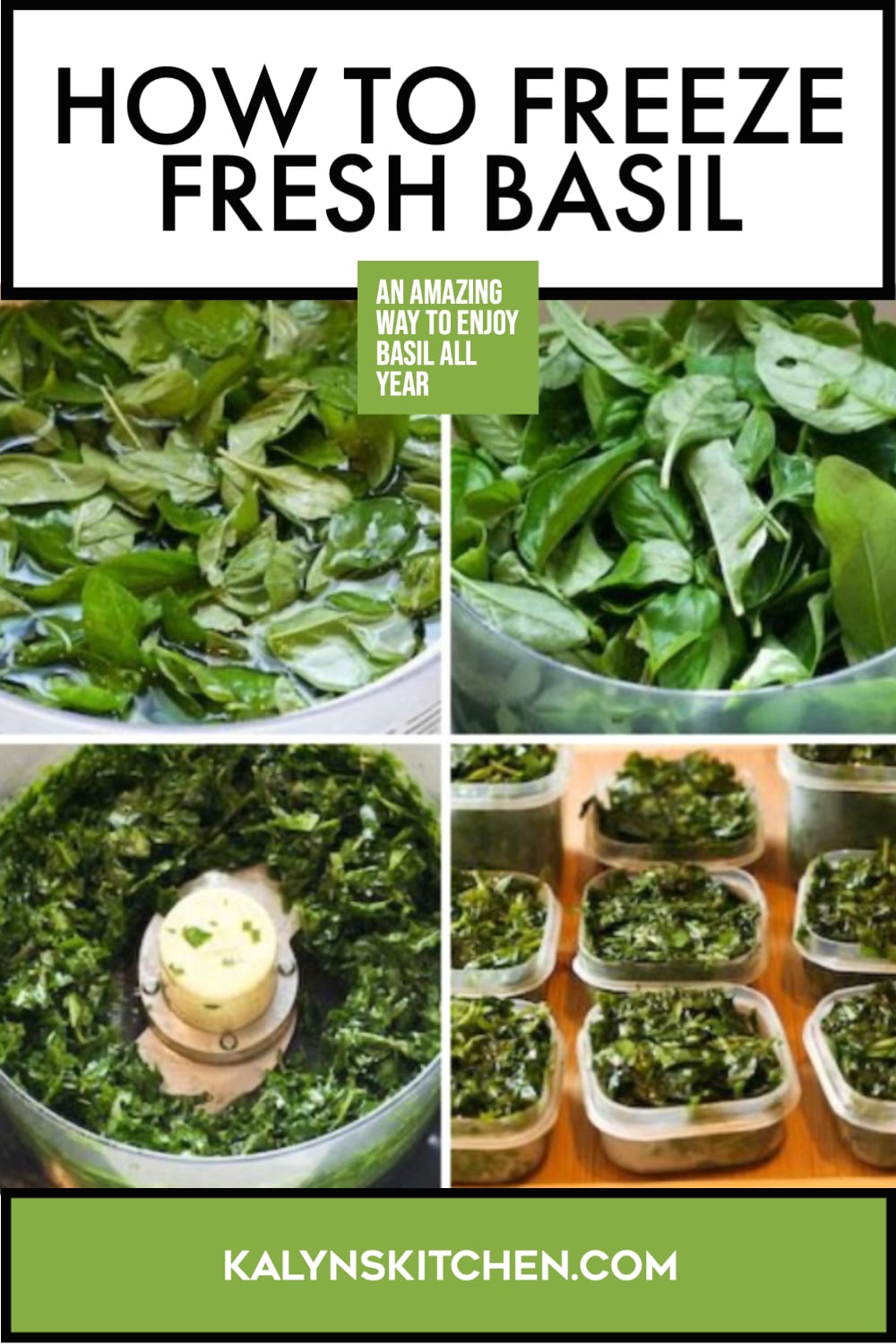To freeze basil, blanch the leaves in boiling water for a few seconds, then transfer to an ice bath. Pat dry and store in airtight containers.
Freezing basil is an excellent way to preserve its fresh flavor for year-round use. Fresh basil has a short shelf life, making preservation essential for enjoying it long-term. Blanching the leaves helps maintain their vibrant color and flavor. An ice bath stops the cooking process, ensuring the basil remains fresh.
After patting the leaves dry, store them in airtight containers or freezer bags to prevent freezer burn. This method keeps your basil ready for soups, sauces, and other dishes. With these steps, you’ll always have fresh basil on hand for your culinary creations.
Introduction To Freezing Basil
Freezing basil is a great way to preserve its fresh flavor. Basil can be enjoyed throughout the year by freezing it. This simple method helps keep the herb’s taste and aroma.
In this guide, you will learn how to freeze basil properly. Freezing basil is easy and quick. Let’s dive into the details.
Why Freeze Basil?
Fresh basil can spoil quickly. Freezing basil extends its shelf life. You can always have basil ready for your recipes.
Fresh basil is often abundant in summer. Freezing helps you save excess basil for winter. This way, you reduce waste and enjoy fresh herbs anytime.
Benefits Of Freezing
Freezing basil locks in its nutrients. The vitamins and minerals remain intact. This makes frozen basil a healthy choice.
Frozen basil retains its flavor and aroma. This is ideal for cooking. You can add it directly to your dishes without thawing.
Freezing basil is convenient. You can store it in small portions. This makes it easy to use in different recipes.
| Benefits | Description |
|---|---|
| Extended Shelf Life | Basil lasts longer when frozen. |
| Reduced Waste | Save excess basil from spoiling. |
| Convenience | Store in small, easy-to-use portions. |
Follow these tips for the best results. Your frozen basil will be just like fresh. Happy freezing!
Selecting Fresh Basil
Freezing basil is a great way to preserve its flavor. To do this well, start by selecting fresh basil. Fresh basil ensures the best taste and texture after freezing.
Choosing The Best Leaves
Look for bright green leaves. Avoid any leaves with yellow spots. The leaves should be firm and not wilted.
- Bright green color
- No yellow spots
- Firm texture
- No wilting
When To Harvest
Harvest basil in the morning. The leaves are freshest at this time. Pick leaves before the basil flowers. Once it flowers, the taste changes.
- Harvest in the morning
- Pick before flowering
- Avoid harvesting on very hot days
Preparation For Freezing
Freezing basil is a great way to preserve its fresh flavor. Proper preparation is key to maintaining its taste and texture. Here’s a simple guide to get your basil ready for freezing.
Washing And Drying
Washing your basil is the first step. Fill a bowl with cold water and gently submerge the basil leaves. Swirl them around to remove dirt and debris. Lift the leaves out and let the water drain.
Drying the basil is crucial. Wet leaves can cause freezer burn. Spread the leaves on a clean towel. Pat them gently with another towel to remove excess moisture. Let them air dry completely for about an hour.
Removing Stems
Removing stems is the next step. Basil stems can be tough and bitter. Hold a basil stem in one hand. With the other hand, pluck the leaves off the stem. Discard the stems or compost them.
Now, your basil leaves are ready for freezing. This simple preparation ensures the best flavor and texture.

Credit: champagne-tastes.com
Freezing Methods
Preserving fresh basil by freezing it can keep its vibrant flavor intact. You can use different freezing methods to store basil for future use. This section covers two effective methods: freezing whole leaves and chopping and freezing.
Freezing Whole Leaves
Freezing whole basil leaves is a simple and effective way to preserve their flavor. Follow these steps:
- Wash and dry the basil leaves thoroughly.
- Place the leaves in a single layer on a baking sheet.
- Freeze the leaves for about 2 hours.
- Transfer the frozen leaves to a freezer-safe bag or container.
- Label the bag with the date for easy tracking.
Tip: You can also blanch the leaves before freezing. This helps maintain their bright green color.
Chopping And Freezing
Another method is to chop the basil and freeze it. This is great for ready-to-use portions:
- Wash and dry the basil leaves thoroughly.
- Chop the basil into small pieces.
- Place the chopped basil into ice cube trays.
- Fill each compartment with a small amount of water or olive oil.
- Freeze the trays until the basil cubes are solid.
- Transfer the frozen basil cubes to a freezer-safe bag or container.
- Label the bag with the date for easy tracking.
Tip: Using olive oil instead of water can add extra flavor to your dishes.
| Method | Steps | Tips |
|---|---|---|
| Freezing Whole Leaves |
| Blanch for green color |
| Chopping and Freezing |
| Use olive oil for extra flavor |
Using Ice Cube Trays
Freezing basil is a great way to preserve its freshness. One efficient method is using ice cube trays. This method ensures the basil is easy to use later.
Creating Basil Cubes
Start by washing the fresh basil leaves thoroughly. Pat them dry with a paper towel. Chop the basil into small pieces.
Place the chopped basil into the ice cube tray compartments. Fill each compartment about halfway. Pour olive oil or water over the basil until the compartment is full.
Place the tray in the freezer. Allow it to freeze completely. This usually takes a few hours. Once frozen, pop the basil cubes out of the tray.
Storing Basil Cubes
Transfer the basil cubes into a labeled freezer bag. Ensure the bag is airtight to prevent freezer burn. Store the bag in the freezer.
Use the basil cubes as needed. Simply add a cube to your dish while cooking. This method keeps the basil fresh and flavorful.
| Steps | Details |
|---|---|
| Wash and Dry Basil | Wash leaves and pat them dry with a paper towel. |
| Chop Basil | Chop basil into small pieces. |
| Fill Ice Cube Trays | Place chopped basil in trays and fill with olive oil or water. |
| Freeze | Freeze the trays until the basil cubes are solid. |
| Store | Transfer cubes to a labeled freezer bag and store in the freezer. |

Credit: www.platingsandpairings.com
Vacuum Sealing
Vacuum sealing is an excellent method to preserve basil. It keeps basil fresh and flavorful for a long time. This method is simple and effective. Let’s dive into the benefits and steps of vacuum sealing basil.
Benefits Of Vacuum Sealing
- Extended Shelf Life: Vacuum sealing can extend the shelf life of basil. It prevents air from causing spoilage.
- Maintains Freshness: Basil stays fresh and green. The flavor and aroma are preserved well.
- Prevents Freezer Burn: Basil is protected from freezer burn. It stays perfect for cooking.
- Saves Space: Vacuum-sealed bags take up less space in the freezer. It helps in organizing your freezer efficiently.
Steps To Vacuum Seal
- Wash and Dry: Start by washing the basil leaves. Pat them dry with a paper towel.
- Pre-Freeze: Spread the basil leaves on a baking sheet. Freeze them for 1-2 hours.
- Prepare Vacuum Sealer: Get your vacuum sealer and bags ready. Follow the manufacturer’s instructions.
- Place Basil in Bags: Place the pre-frozen basil leaves in the vacuum sealer bags. Ensure the leaves are spread out evenly.
- Seal the Bags: Use the vacuum sealer to remove air and seal the bags. Make sure the seal is tight.
- Store in Freezer: Label the bags with the date. Store them in the freezer for future use.
By following these steps, your basil will stay fresh and ready for any recipe. Enjoy the vibrant taste of basil all year round!
Storing Frozen Basil
After freezing your basil, proper storage is crucial. This keeps it fresh and flavorful. Follow these simple steps to store your frozen basil correctly.
Labeling And Dating
Always label and date your frozen basil packages. This helps you keep track of how long they have been stored. You can use a permanent marker to write on freezer bags or containers.
| Step | Description |
|---|---|
| Label | Write “Basil” on the package |
| Date | Include the freezing date |
Optimal Storage Conditions
Store your frozen basil at the optimal temperature of 0°F (-18°C) or lower. This ensures the basil remains fresh for up to six months.
- Use airtight containers or freezer bags
- Remove as much air as possible before sealing
- Keep the basil in the coldest part of the freezer
By following these steps, you can enjoy fresh basil flavors even in the off-season. Always remember to label, date, and store your basil correctly.
Thawing And Using Frozen Basil
Freezing basil preserves its fresh flavor for months. But knowing how to thaw and use it properly is crucial. This section will guide you through the best practices for thawing and cooking with frozen basil.
How To Thaw
Thawing frozen basil is simple and quick. Follow these steps:
- Remove the basil from the freezer.
- Place it on a plate or bowl.
- Let it sit at room temperature for 10-15 minutes.
- Once thawed, use paper towels to absorb excess moisture.
For faster thawing, use these methods:
- Microwave on a low setting for 10-15 seconds.
- Run the basil under cold water for a few seconds.
Cooking Tips
Using thawed basil enhances your dishes. Here are some tips:
- Add thawed basil at the end of cooking for a fresh taste.
- Use it in sauces, soups, and stews for extra flavor.
- Mix thawed basil into pesto, dressings, and dips.
For best results, follow these guidelines:
| Dish | When to Add Basil |
|---|---|
| Soups | During the last 5 minutes of cooking |
| Pastas | Right before serving |
| Sauces | After removing from heat |
Frozen basil may lose some texture, but the flavor remains strong. Use it wisely to enhance your meals.
Common Mistakes To Avoid
Freezing basil is a great way to preserve its fresh flavor. Yet, many make common mistakes that spoil its taste and texture. Avoid these pitfalls to keep your basil fresh and tasty.
Improper Washing
Always wash basil leaves before freezing. Dirty leaves can carry bacteria and dirt. Rinse the leaves under cold water. Gently pat them dry with a paper towel. Wet leaves can form ice crystals, ruining the texture.
| Proper Washing Steps | Details |
|---|---|
| Rinse under cold water | Remove dirt and bacteria |
| Pat dry with paper towel | Prevent ice crystals from forming |
Incorrect Storage Techniques
Storing basil incorrectly can lead to freezer burn. Use airtight containers or freezer bags. Avoid plastic wraps and loose bags. Label the containers with the date. This helps you keep track of freshness.
- Use airtight containers
- Avoid plastic wraps
- Label with date
Remove as much air as possible from the bags. This prevents freezer burn and keeps basil fresh longer.

Credit: kalynskitchen.com
Frequently Asked Questions
How Do You Freeze Fresh Basil Leaves?
To freeze fresh basil leaves, first wash and dry them. Then, spread them on a baking sheet. Freeze until solid, and transfer to a freezer bag.
Can You Freeze Basil Without Blanching?
Yes, you can freeze basil without blanching. Wash and dry the leaves. Freeze them on a baking sheet, then store in a freezer bag.
Does Freezing Basil Affect Flavor?
Freezing basil can slightly affect its texture but retains most of its flavor. Using it in cooked dishes helps preserve its taste.
How Long Does Frozen Basil Last?
Frozen basil can last up to six months in the freezer. Store it in airtight bags or containers for best results.
Conclusion
Freezing basil is an easy way to preserve its fresh flavor. Follow these steps to enjoy basil year-round. By freezing, you reduce waste and always have herbs on hand. Try this method and elevate your cooking with fresh basil anytime.
Your dishes will taste even better with this simple technique.
